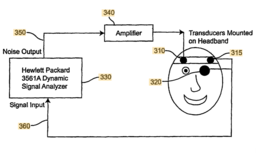Method and Apparatus for Monitoring Intra Ocular and Intra Cranial Pressure
TECHNOLOGY NUMBER: 6856

OVERVIEW
A non-invasive device that can detect increased intracranial pressure (ICP)- Uses an ultrasound generator to produce an acoustic signal measured by an eye patch sensor
- Useful in hospital settings or by first responders at motor vehicle accident sites or on battlefields
BACKGROUND
The brain is bathed in and surrounded by cerebrospinal fluid (CSF) which is maintained during periods of homeostasis at a specific intracranial pressure (ICP) to protect intracranial structures and optimize neurologic functioning. Increased ICP can result from several different causes and poses a clinical problem that must be managed to prevent severe brain damage or even death. Intracranial pressure changes are commonly measured invasively by implanting devices directly into the skull cavity or by lumbar puncture. The inherent limitations associated with invasive devices have fostered efforts to create non-invasive techniques to measure ICP.The anatomic “windows” to the intracranial space are the eyes and ears, though efforts to reproducibly monitor ICP through these structures have not yielded successful results. While the eye is more accessible than the ear and intraocular pressure does correlate with ICP, existing efforts to measure ICP by evaluating eye pressure have shown conflicting and non-reproducible results. A need exists for a portable, non-invasive sensor for measuring ICP in casualties with traumatic head injury and hospitalized patients with a variety of clinical circumstances.
INNOVATION
Researchers have developed a method to apply acoustic energy to the head that is measured by piezoelectric film sensors in eye patches to successfully estimate intracranial pressure. In this device an ultrasonic sweep generator applies an acoustic signal across the patient's skull at a predetermined range that is dampened in a manner that correlates with ICP. The skull, brain, and eyes all act as resonant structures which transmit the sound waves. The eye patch sensors can detect the resonant frequency of sound, or the acoustic signals can be created at a range of less than 20 kHz to permit the analyzer to determine retinal artery pulsations. The eye patches are comfortable and rapidly provides readings that are sensitive, accurate, and reproducible. The device is portable and can be used in hospitals or in settings where head trauma patients are assessed by first responders, such as at the site of motor vehicle accidents or on battlefields.